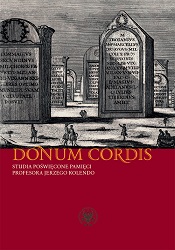Logistyka w pigułce. „Papirus Hunta” jako podsumowanie
problemu zaopatrzenia armii rzymskiej w Mezji Dolnej
Logistics in a nutshell: “Hunt’s papyrus” as a synopsis of the problem of supplying the Roman army in Moesia Inferior
Author(s): Martin Lemke
Subject(s): Archaeology
Published by: Wydawnictwa Uniwersytetu Warszawskiego
Keywords: Jerzy Kolendo; archaeology; Poland; Europe; University of Warsaw; Polish Academy of Sciences
Summary/Abstract: Understanding army logistics is important for understanding the Roman army and the Roman limes as such,especially the fundamental and dual role of the Danube. Camps and smaller garrisons were located depending onstrategic reasons. This included a thorough analysis of what the province could provide and also the stable coordinationof army supplies by specialized personnel. The logistics, especially of the 1st century, could have beenpartly improvised, which also required a specifi c skillset to be carried out, but overall they were proof of welldevised organization and planning ahead. Studying the logistics of the Roman army in Moesia Inferior, one hasa particular advantage, namely the British Museum Papyrus 2851. This particular fi nd enhances our knowledge,at the same time serving as a “synopsis” of the entire topic. The object in question has also been labelled Hunt’sPridianum or, somewhat imprecisely, but clearly enough for those interested in the topic — Hunt’s papyrus.We don’t know the exact provenance of this fi nd. The form of the document is comparable to a common pridianum,an annual personnel register or roster of an army unit. Apart from information on individual soldiers andunits, the system of army documentation also included data on current issues, such as the supply of food, arms,equipment, raw material and other goods, so that the commanding offi cers would know what they had at theirdisposal and could thus anticipate the necessary expenses and properly document them. The unit in question isthe cohors I Hispanorum veterana, which belonged to the garrison of Egypt before it was moved to Moesia Inferior.From this and other Roman army administrative documents, such as the Vindolanda tablets or other papyri fromEgypt and Dura Europos, we also learn that the soldiers of a single unit could be dispersed over a large areawhen acquiring supplies, so the cohors I Hispanorum veterana was no exception in this regard.
Book: Donum cordis. Studia poświęcone pamięci Profesora Jerzego Kolendo
- Page Range: 186-195
- Page Count: 9
- Publication Year: 2019
- Language: English, Polish, German
- Content File-PDF

